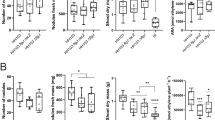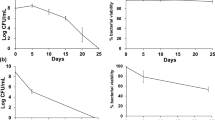Abstract
The Gram-negative plant pathogen Xanthomonas campestris pv. campestris (Xcc) is the causative agent of black rot in crucifers. The production of Xcc virulence factors is regulated by Clp and RpfF. HD-related output domain (HDOD) is a protein domain of unknown biochemical function. The genome of Xcc encodes three proteins (GsmR, HdpA, and HdpB) with an HDOD. The GsmR has been reported to play a role in the general stress response and cell motility and its expression is positively regulated by Clp. Here, the function and transcription of hdpA and hdpB were characterized. Mutation of hdpA resulted in enhanced bacterial attachment. In addition, the expression of hdpA was positively regulated by RpfF but not by Clp, subject to catabolite repression and affected by several stress conditions. However, mutational analysis and reporter assay showed that hdpB had no effect on the production of a range of virulence factors and its expression was independent of Clp and RpfF. The results shown here not only extend the previous work on RpfF regulation to show that it influences the expression of hdpA in Xcc, but also expand knowledge of the function of the HDOD containing proteins in bacteria.






Similar content being viewed by others
Abbreviations
- AAP:
-
Abridged anchor primer
- AUAP:
-
Abridged universal amplification primer
- DSF:
-
Diffusible signal factor
- HDOD:
-
HD-related output domain
- RACE:
-
Rapid amplification of cDNA ends
- rpf :
-
Regulation of pathogenicity factors
- Xcc:
-
Xanthomonas campestris pv. campestris
References
An SQ et al (2013) High-resolution transcriptional analysis of the regulatory influence of cell-to-cell signalling reveals novel genes that contribute to Xanthomonas phytopathogenesis. Mol Microbiol 88:1058–1069. doi:10.1111/mmi.12229
Barber CE et al (1997) A novel regulatory system required for pathogenicity of Xanthomonas campestris is mediated by a small diffusible signal molecule. Mol Microbiol 24:555–566
Bogdanove AJ et al (2011) Two new complete genome sequences offer insight into host and tissue specificity of plant pathogenic Xanthomonas spp. J Bacteriol 193:5450–5464. doi:10.1128/JB.05262-11
Buttner D, Bonas U (2010) Regulation and secretion of Xanthomonas virulence factors. FEMS Microbiol Rev 34:107–133. doi:10.1111/j.1574-6976.2009.00192.x
Chan JW, Goodwin PH (1999) The molecular genetics of virulence of Xanthomonas campestris. Biotechnol Adv 17:489–508
Crossman LC et al (2008) The complete genome, comparative and functional analysis of Stenotrophomonas maltophilia reveals an organism heavily shielded by drug resistance determinants. Genome Biol 9:R74. doi:10.1186/gb-2008-9-4-r74
da Silva AC et al (2002) Comparison of the genomes of two Xanthomonas pathogens with differing host specificities. Nature 417:459–463
Darrasse A et al (2013) Genome sequence of Xanthomonas fuscans subsp. fuscans strain 4834-R reveals that flagellar motility is not a general feature of xanthomonads. BMC Genom 14:761. doi:10.1186/1471-2164-14-761
Dow JM, Daniels MJ (1994) Pathogenicity determinants and global regulation of pathogenicity of Xanthomonas campestris pv. campestris. Curr Top Microbiol Immunol 192:29–41
Dow JM, Crossman L, Findlay K, He YQ, Feng JX, Tang JL (2003) Biofilm dispersal in Xanthomonas campestris is controlled by cell-cell signaling and is required for full virulence to plants. Proc Natl Acad Sci USA 100:10995–11000. doi:10.1073/pnas.1833360100
Finn RD et al (2014) Pfam: the protein families database. Nucleic Acids Res 42:D222–D230. doi:10.1093/nar/gkt1223
Fu JF, Tseng YH (1990) Construction of lactose-utilizing Xanthomonas campestris and production of xanthan gum from whey. Appl Environ Microbiol 56:919–923
Galperin MY (2006) Structural classification of bacterial response regulators: diversity of output domains and domain combinations. J Bacteriol 188:4169–4182. doi:10.1128/JB.01887-05
Galperin MY, Nikolskaya AN, Koonin EV (2001) Novel domains of the prokaryotic two-component signal transduction systems. FEMS Microbiol Lett 203:11–21
Hanahan D (1983) Studies on transformation of Escherichia coli with plasmids. J Mol Biol 166:557–580
He YW, Wang C, Zhou L, Song H, Dow JM, Zhang LH (2006a) Dual signaling functions of the hybrid sensor kinase RpfC of Xanthomonas campestris involve either phosphorelay or receiver domain-protein interaction. J Biol Chem 281:33414–33421
He YW et al (2006b) Genome scale analysis of diffusible signal factor regulon in Xanthomonas campestris pv. campestris: identification of novel cell-cell communication-dependent genes and functions. Mol Microbiol 59:610–622
He YW, Ng AY, Xu M, Lin K, Wang LH, Dong YH, Zhang LH (2007) Xanthomonas campestris cell-cell communication involves a putative nucleotide receptor protein Clp and a hierarchical signalling network. Mol Microbiol 64:281–292
Hendrixson DR, DiRita VJ (2004) Identification of Campylobacter jejuni genes involved in commensal colonization of the chick gastrointestinal tract. Mol Microbiol 52:471–484
Hengge R (2009) Principles of c-di-GMP signalling in bacteria. Nat Rev Microbiol 7:263–273. doi:10.1038/nrmicro2109
Hsiao YM, Liao HY, Lee MC, Yang TC, Tseng YH (2005) Clp upregulates transcription of engA gene encoding a virulence factor in Xanthomonas campestris by direct binding to the upstream tandem Clp sites. FEBS Lett 579:3525–3533
Hsiao YM, Zheng MH, Hu RM, Yang TC, Tseng YH (2008) Regulation of the pehA gene encoding the major polygalacturonase of Xanthomonas campestris by Clp and RpfF. Microbiology 154:705–713
Hsiao YM, Liu YF, Fang MC, Song WL (2011a) XCC2731, a GGDEF domain protein in Xanthomonas campestris, is involved in bacterial attachment and is positively regulated by Clp. Microbiol Res 166:548–565. doi:10.1016/j.micres.2010.11.003
Hsiao YM, Liu YF, Lee PY, Hsu PC, Tseng SY, Pan YC (2011b) Functional characterization of copA gene encoding multicopper oxidase in Xanthomonas campestris pv. campestris. J Agric Food Chem 59:9290–9302. doi:10.1021/jf2024006
Hsiao YM, Song WL, Liao CT, Lin IH, Pan MY, Lin CF (2012) Transcriptional analysis and functional characterization of XCC1294 gene encoding a GGDEF domain protein in Xanthomonas campestris pv. campestris. Arch Microbiol 194:293–304. doi:10.1007/s00203-011-0760-3
Jalan N et al (2011) Comparative genomic analysis of Xanthomonas axonopodis pv. citrumelo F1, which causes citrus bacterial spot disease, and related strains provides insights into virulence and host specificity. J Bacteriol 193:6342–6357. doi:10.1128/JB.05777-11
Jalan N, Kumar D, Yu F, Jones JB, Graham JH, Wang N (2013) Complete genome sequence of Xanthomonas citri subsp. citri strain Aw12879, a restricted-host-range citrus canker-causing bacterium. Genome Announc 1:e00235–00213 doi:10.1128/genomeA.00235-13
Jenal U (2004) Cyclic di-guanosine-monophosphate comes of age: a novel secondary messenger involved in modulating cell surface structures in bacteria? Curr Opin Microbiol 7:185–191. doi:10.1016/j.mib.2004.02.007
Jenal U, Malone J (2006) Mechanisms of cyclic-di-GMP signaling in bacteria. Annu Rev Genet 40:385–407. doi:10.1146/annurev.genet.40.110405.090423
Keen NT, Tamaki S, Kobayashi D, Trollinger D (1988) Improved broad-host-range plasmids for DNA cloning in gram-negative bacteria. Gene 70:191–197
Lee TC, Chen ST, Lee MC, Chang CM, Chen CH, Weng SF, Tseng YH (2001) The early stages of filamentous phage ϕLf infection require the host transcription factor. Clp J Mol Microbiol Biotechnol 3:471–481
Liao CT, Du SC, Lo HH, Hsiao YM (2014) The galU gene of Xanthomonas campestris pv. campestris is involved in bacterial attachment, cell motility, polysaccharide synthesis, virulence, and tolerance to various stresses. Arch Microbiol 196:729–738. doi:10.1007/s00203-014-1012-0
Lira F, Hernandez A, Belda E, Sanchez MB, Moya A, Silva FJ, Martinez JL (2012) Whole-genome sequence of Stenotrophomonas maltophilia D457, a clinical isolate and a model strain. J Bacteriol 194:3563–3564. doi:10.1128/JB.00602-12
Liu YF, Liao CT, Song WL, Hsu PC, Du SC, Lo HH, Hsiao YM (2013) GsmR, a response regulator with an HD-related output domain in Xanthomonas campestris, is positively controlled by Clp and is involved in the expression of genes responsible for flagellum synthesis. FEBS J 280:199–213. doi:10.1111/febs.12061
McCarthy Y et al (2008) The role of PilZ domain proteins in the virulence of Xanthomonas campestris pv. campestris. Mol Plant Pathol 9:819–824. doi:10.1111/j.1364-3703.2008.00495.x
Miller JH (1972) Experiments in molecular genetics. Cold Spring Habor Laboratory, Cold Spring Harbor
Muller D et al (2007) A tale of two oxidation states: bacterial colonization of arsenic-rich environments. Plos Genet 3:e53. doi:10.1371/journal.pgen.0030053
Qian W et al (2005) Comparative and functional genomic analyses of the pathogenicity of phytopathogen Xanthomonas campestris pv. campestris. Genome Res 15:757–767
Qian W, Han ZJ, Tao J, He C (2008) Genome-scale mutagenesis and phenotypic characterization of two-component signal transduction systems in Xanthomonas campestris pv. campestris ATCC 33913. Mol Plant Microbe Interact 21:1128–1138. doi:10.1094/MPMI-21-8-1128
Romling U, Gomelsky M, Galperin MY (2005) C-di-GMP: the dawning of a novel bacterial signalling system. Mol Microbiol 57:629–639. doi:10.1111/j.1365-2958.2005.04697.x
Ryan RP et al (2006) Cell-cell signaling in Xanthomonas campestris involves an HD-GYP domain protein that functions in cyclic di-GMP turnover. Proc Natl Acad Sci USA 103:6712–6717
Ryan RP et al (2007) Cyclic di-GMP signalling in the virulence and environmental adaptation of Xanthomonas campestris. Mol Microbiol 63:429–442
Ryan RP, McCarthy Y, Andrade M, Farah CS, Armitage JP, Dow JM (2010) Cell-cell signal-dependent dynamic interactions between HD-GYP and GGDEF domain proteins mediate virulence in Xanthomonas campestris. Proc Natl Acad Sci USA 107:5989–5994
Ryan RP, McCarthy Y, Kiely PA, O’Connor R, Farah CS, Armitage JP, Dow JM (2012) Dynamic complex formation between HD-GYP, GGDEF and PilZ domain proteins regulates motility in Xanthomonas campestris. Mol Microbiol 86:557–567. doi:10.1111/mmi.12000
Sambrook J, Fritsch EF, Maniatis T (1989) Molecular cloning: a laboratory manual, 2nd edn. Cold Spring Habor Press, Cold Spring Harbor
Schirmer T, Jenal U (2009) Structural and mechanistic determinants of c-di-GMP signalling. Nat Rev Microbiol 7:724–735. doi:10.1038/nrmicro2203
Schweizer HD (1993) Small broad-host-range gentamycin resistance gene cassettes for site-specific insertion and deletion mutagenesis. Biotechniques 15:831–834
Slater H, Alvarez-Morales A, Barber CE, Daniels MJ, Dow JM (2000) A two-component system involving an HD-GYP domain protein links cell-cell signalling to pathogenicity gene expression in Xanthomonas campestris. Mol Microbiol 38:986–1003
Thieme F et al (2005) Insights into genome plasticity and pathogenicity of the plant pathogenic bacterium Xanthomonas campestris pv. vesicatoria revealed by the complete genome sequence. J Bacteriol 187:7254–7266
Tseng YH et al (1999) Chromosome map of Xanthomonas campestris pv. campestris 17 with locations of genes involved in xanthan gum synthesis and yellow pigmentation. J Bacteriol 181:117–125
Vieira J, Messing J (1991) New pUC-derived cloning vectors with different selectable markers and DNA replication origins. Gene 100:189–194
Vorholter FJ et al (2008) The genome of Xanthomonas campestris pv. campestris B100 and its use for the reconstruction of metabolic pathways involved in xanthan biosynthesis. J Biotechnol 134:33–45
Wang TW, Tseng YH (1992) Electrotransformation of Xanthomonas campestris by RF DNA of filamentous phage ϕLf. Lett Appl Microbiol 14:65–68
Williams PH (1980) Black rot: a continuing threat to world crucifers. Plant Dis 64:736–742
Yang BY, Tseng YH (1988) Production of exopolysaccharide and levels of protease and pectinase activity in pathogenic and non-pathogenic strains of Xanthomonas campestris pv. campestris. Bot Bull Acad Sin 29:93–99
Acknowledgments
This study was supported by National Science Council of Taiwan Grant No. NSC 101-2313-B-166-001-MY3 to Yi-Min Hsiao.
Author information
Authors and Affiliations
Corresponding author
Electronic supplementary material
Below is the link to the electronic supplementary material.
Rights and permissions
About this article
Cite this article
Lee, HM., Liao, CT., Chiang, YC. et al. Characterization of genes encoding proteins containing HD-related output domain in Xanthomonas campestris pv. campestris. Antonie van Leeuwenhoek 109, 509–522 (2016). https://doi.org/10.1007/s10482-016-0656-y
Received:
Accepted:
Published:
Issue Date:
DOI: https://doi.org/10.1007/s10482-016-0656-y




